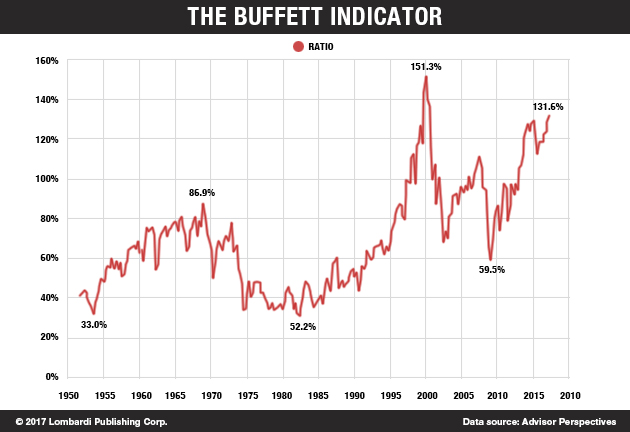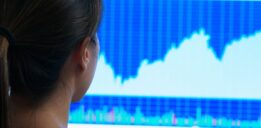The Buffett Indicator Suggests We’re in a Stock Market Bubble and It Could Burst Anytime
When asked what their investment approach is, many people around the world answer with little doubt. More often than not, they say “I like to invest like Warren Buffett.” Well, that’s great. The market is flying again. The minor correction from the North Korean scare didn’t last the weekend and a couple of hurricanes. In fact, investors are not following Buffett’s advice at all. Indeed, they’re doing the opposite because Warren Buffett’s favorite stock market indicator—the Buffett Indicator—is hitting its highest levels since the dot-com bubble.
Also Read: Warren Buffett Indicator Predicts Stock Market Crash in 2017
Before delving into the Buffett Indicator, what is Warren Buffett’s investment approach? At 87 years of age, the famous American billionaire has always focused on a few pillars of portfolio management. He is not like the other stars of investment funds. But he’s clearly picked some good stocks and played them right because he’s the fourth richest man in the world according to Bloomberg’s “Billionaires Index.” Warren Buffett’s net worth is an estimated $76.6 billion.
For Buffett to have been successful year after year, he is clearly not operating on fluke alone. He’s not known to consult astrologers or crystal balls either. Rather, through the good services of his firm Berkshire Hathaway Inc. (NYSE:BRK.A) he has followed a clear and simple approach, one he has always outlined in his shareholder letters since 1977. (Source: “Shareholder Letters,” Berkshire Hathaway Inc., last accessed September 12, 2017.)
Warren Buffett Doesn’t Like Expensive Assets
Warren Buffett makes no secret he has followed the advice of John C. Bogle, who founded Vanguard, an investment management company. It is based on common sense. For the purposes of the current market, the approach favors selecting cheap funds, using past performance as a barometer to assess the company/sector risks and especially management’s talent. Yet, Bogle also urged caution. He advised investors to avoid spending too much money.
By that, Bogle intends for investors to avoid expensive assets. What’s best is to own stocks in the market at the lowest cost that’s reasonable. (Source: “Invest Like a Legend: John Bogle,” The Globe and Mail, January 26, 2017.)
Now, looking at the market today, with price-to-earnings values on average well above 22 times, cheap is not the first word that comes to mind.
Indeed, by Buffett’s standard, the market is crazy expensive. One of Buffett’s favorite indicators expresses the relationship between gross domestic product (GDP) and corporate equities. This ratio spiked in 2007 and 2008, just before the Lehman Brothers crack and the explosion of the subprime mortgage-fueled bubble.
The picture that the Buffett Indicator is painting sends the proverbial dire warning.
Whereas in the last year of the “gold standard” for the dollar, the total value of the stock market represented around 80% of the value of the entire U.S. economy. It moved more toward 40% of GDP after. Note, in 2000 around the period when the dot-com bubble burst on the scene, the market and GDP were neck and neck (way higher than the original 40% of 1971).
The Stock Market Is Trading at Some One-and-a-Half Times GDP
Now, the market is trading at almost one-and-a-half times the value of GDP.
In short, Warren Buffett would be too proud of anyone claiming to have been inspired by his strategy, who is investing heavily in the present market. Buffett’s famous indicator of choice is pointing to the high risk of a bubble. Note that if Kim Jong-un had proceeded with the nuclear test many expected, the market story on September 11, 2017, might have been rather different. That event could have triggered a stock market crash.
The trend of the past few weeks has shown that this is possible. A correction has already started. Kim is still sitting pretty in Pyongyang while after the patriotism and just remembrance of the 9/11 attacks, the markets will be loosened again. How high will they go before people realize they’re climbing to excessive heights?
The current bubble has been fueled by both. Rumor, because as in the case of dot-com companies, tech stocks are leading the race to fantastical valuations: note Snap Inc. (NYSE:SNAP). But the overall market would have burst weeks ago, had the Federal Reserve not chosen to postpone the next rate hike.
What the Buffett Indicator is telling us is this: Investors are buying stocks without taking into account their profits, EP reports, cash flows, or even a basic analysis of the products the companies are peddling. Waking up from this dream will be expensive.







